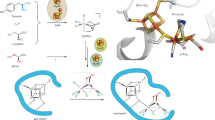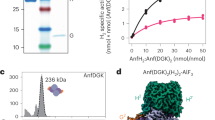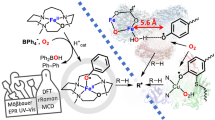Abstract
THE iron-containing bacterioferritins1–6 contain the protoporphyrin IX haem group5. It has been established that Escherichia coli cytochrome b1, cytochrome b557 and bacterioferritin are identical7. The optical spectra at room temperature of the haem group show it to be predominantly low-spin in both the ferrous and ferric states8. The nature of the axial ligands binding the haem group to the polypeptide has, however, remained unknown. Low-spin, bis-coordinate haem centres in proteins typically have a role in rapid electron transfer as redox changes at the metal ion lead to little structural rearrangement9. There are only four amino acids with side-chains that have ligand field strengths sufficient to generate the low-spin state of haem, namely, histidine, lysine, methionine and cysteine. Hence there are, potentially, ten different pairs of these four ligands which could be discovered in electron transferhaemoproteins. To date only three have been established with certainty. They are bis-histidine, as in mammalian cytochrome b5 (ref. 10), methionine-histidine, typified by cytochrome c (ref. 11) and lysine-histidine, recently recognized by spectroscopic methods in cytochrome f (ref. 12). Here we report the electron paramagnetic resonance and near infrared magnetic circular dichroism spectra of the oxidized state of Ps. aeruginosa bacterioferritin which enable the axial ligands to be identified as the thioether side chains of two methionine residues, a ligation scheme not previously reported for haem in any protein.
This is a preview of subscription content, access via your institution
Access options
Subscribe to this journal
Receive 51 print issues and online access
$199.00 per year
only $3.90 per issue
Buy this article
- Purchase on Springer Link
- Instant access to full article PDF
Prices may be subject to local taxes which are calculated during checkout
Similar content being viewed by others
References
Ford, G. C. et al. Phil. Trans. R. Soc. B304, 551–565 (1984).
Laulhere, J. P., Lescurie, A. M. & Briat, J. F. J. biol. Chem. 263, 10289–10294 (1988).
Yariv, J. et al. Biochem. J. 197, 171–175 (1981).
Stiefel, E. I. & Watt, G. D. Nature 279, 81–83 (1979).
Moore, G. R., Mann, S. & Bannister, J. V. J. Inorg. Biochem. 28, 329–336 (1986).
Smith, J. M. A., Ford, G. C. & Harrison, P. M. Biochem. Soc. Trans. 16, 836–838 (1988).
Smith, J. M. A., Quirk, A. V., Plank, R. W. H., Diffin, F. M., Ford, G. C. & Harrison, P. M. Biochem. J. 255, 737–740 (1988).
Moore, G. R. Biochem. J. 227, 341–342 (1985).
Moore, G. R. & Pettigrew, G. W. Cytochromes c: Evolutionary, Structural and Physico-chemical Aspects 370–372 (Springer, New York, Heidelberg, 1990).
Mathews, F. S. Prog. Biophys. molec. Biol. 45, 1–56 (1985).
Dickerson, R. E. & Timkovich, R. The Enzymes 3rd edn, Vol. 11 (ed. Boyer, P. D.) 397–547 (Academic. London, 1975).
Rigby, S. E. J. et al. Biochem. J. 256, 571–577 (1988).
Gadsby, P. M. A. & Thomson, A. J. J. Amer. chem. Soc. 112, 5003–5011 (1990).
Smith, D. W. & Williams, R. J. P. Struct. Bonding 7, 1–45 (1970).
Cheng, J. C., Osborne, G. A., Stephens, P. J. & Eaton, W. A. Nature 241, 193–194 (1973).
Sievers, G., Gadsby, P. M. A., Peterson, J. & Thomson, A. J., Biochim. biophys. Acta 742, 637–647 (1983).
Moore, G. R., Williams, R. J. P., Peterson, J., Thomson, A. J. & Mathews, F. S. Biochim. biophys. Acta 829, 83–96 (1985).
Mashiko, T., Reed, C. A., Haller, K. J., Kastner, M. E. & Scheidt, W. R. J. Am. chem. Soc. 103, 5758–5767 (1981).
Andrews, S. C., Smith, J. M. A., Guest, J. R. & Harrison, P. M. Biochem. biophys. Res. Commun. 158, 489–496 (1989).
Smith, J. M. A., Ford, G. C., Harrison, P. M., Yariv, J. & Kalb A. J. J. molec. Biol. 205, 465–467 (1989).
Harrison, P. M. et al. in Proteins of Iron Storage and Transport (eds Spik, G. et al.) 67–79 (Elsevier, Amsterdam, 1985).
Lederer, F., Glatigany, A., Bethge, P. H., Bellamy, H. D. & Mathews, F. S. J. molec. Biol. 148, 427–448 (1981).
Weber, P. C., Howard, A., Xuong, N. G. H. & Salemme, F. R. J. molec. Biol. 153, 399–424 (1981).
Kurokawa, T., Fukumori, Y. & Yamamoka, T., Biochem. biophys. Acta 976, 135–139 (1989).
Author information
Authors and Affiliations
Rights and permissions
About this article
Cite this article
Cheesman, M., Thomson, A., Greenwood, C. et al. Bis-methionine axial ligation of haem in bacterioferritin from Pseudomonas aeruginosa. Nature 346, 771–773 (1990). https://doi.org/10.1038/346771a0
Received:
Accepted:
Issue Date:
DOI: https://doi.org/10.1038/346771a0
This article is cited by
-
The catalytic center of ferritin regulates iron storage via Fe(II)-Fe(III) displacement
Nature Chemical Biology (2012)
-
Spectral characterization of the recombinant mouse tumor suppressor 101F6 protein
European Biophysics Journal (2010)
-
Designing photosystem II: molecular engineering of photo-catalytic proteins
Photosynthesis Research (2008)
-
Engineering model proteins for Photosystem II function
Photosynthesis Research (2007)
-
Heme binding by a bacterial repressor protein, the gene product of the ferric uptake regulation (fur) gene ofEscherichia coli
Journal of Protein Chemistry (1996)
Comments
By submitting a comment you agree to abide by our Terms and Community Guidelines. If you find something abusive or that does not comply with our terms or guidelines please flag it as inappropriate.



